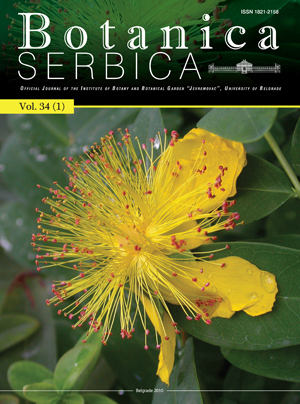
Volume 34 Issue 1 2010 |
| Nickel hyperaccumulation by the species of Alyssum and Thlaspi (Brassicaceae) from the ultramafic soils of the Balkans BANI A, PAVLOVA D, ECHEVARRIA G, MULLAJ A, REEVES RD, MOREL JL & SULÇE S. Pages 3-14 Full reference | Abstract | Full text PDF |
recognized as an unusual response by some plant species to the elevated nickel concentrations generally found in soils derived from ultramafi c rocks (oft en referred to as serpentine soils). Such soils are widespread in the Balkans. Th ese soils host some widespread species and a smaller number of regional or local endemics. Several serpentine areas in Albania (AL), Bulgaria (BG) and Greece (GR) have been surveyed because of the presence of nickel hyperaccumulating endemics, including some that are common for all three studied countries. Th e objectives of the study were to widen understanding of the distribution of the nickel hyperaccumulators and their uptake behaviour in relation to the haracteristics of their native soil environments. Collection and chemical analysis of both plant and soil samples has allowed evaluation of phenotypic effi cacy in hyperaccumulating nickel. In total, eight taxa were studied. In this work the highest Ni concentrations in leaves (1.5- 2.0%) were found in Alyssum murale at Pojska (AL), A. murale at Kazak (BG), A. markgrafi i at Gjegjan (AL) and Th laspi kovatsii at Fotinovo (BG). Th e maximum quotients of plant Ni concentration to soil Ni concentration range from 13.9 for A. markgrafi i to 6-7 for A. murale, T. kovatsii and T. tymphaeum from northern Greece. Eight of the taxa collected in this work show hyperaccumulation of Ni; these include A. murale subsp. pichleri and all of Thlaspi species studied from serpentine in Bulgaria. In total, twentyfive Ni hyperaccumulating taxa are now known from the Brassicaceae of Albania, Bulgaria and Greece. Because of its high biomass production, A. murale is likely to be the most suitable species for Niphytomining in the Balkans.. KEY WORDS: hyperaccumulation, nickel, Alyssum, Thlaspi, ultramafics, the Balkans |
| Growth and ion uptake in maize plants exposed to Pb, Cd and Ni depend on NO3–/NH4+ ratio MIHAILOVIC N. Pages 15-20 Full reference | Abstract | Full text PDF |
KEY WORDS: cadmium, growth, ion uptake, lead, nickel, root, Zea mays. |
| Comparative anatomical study of some gymnospermae species leaves BERCU R, BROASCA L & POPOVICIU R. Pages 21-28 Full reference | Abstract | Full text PDF |
KEY WORDS: anatomy, Gymnospermae, epidermis, leaf, mesophyll, resin ducts, vascular system |
| Production of polyphenolic compounds in shoot cultures of Hypericum species characteristic for the Balkan flora DANOVA K. Pages 29-36 Full reference | Abstract | Full text PDF |
KEY WORDS: Hypericum rumeliacum, H. tetrapterum, H. calycinum, shoot cultures, polyphenolics, cryopreservation.. |
| Rare and threatened plants in the Black Sea coastal area between Cape Midia (Romania) and Cape Kaliakra (Bulgaria) FAGARAS M, ANASTASIU P & GAVRIL N. Pages 37-44 Full reference | Abstract | Full text PDF |
KEY WORDS: rare plants, threatened plants, coastal zone, Black Sea, Dobrogea |
| Comparative leaf epidermis study in species of genus Malus Mill. (Rosaceae) GANEVA T & UZUNOVA K. Pages 45-50 Full reference | Abstract | Full text PDF |
KEY WORDS: epidermis structure, cuticle, Malus |
Histological and physico-chemical evaluation of Buxus wallichiana Baill |
KEY WORDS: Buxus wallichiana, Buxaceae, Antileprotic, Purgative, Diuretic |
| Antifungal and antioxidant activity of Mentha longifolia (L.) Hudson (Lamiaceae) essential oil DŽAMIC AM, SOKOVIC MD, RISTIC MS, NOVAKOVIC M, GRUJIC-JOVANOVIC S, TEŠEVIC V & MARIN PD. Pages 57-62 Full reference | Abstract | Full text PDF |
KEY WORDS: Mentha longifolia, essential oil, antifungal, antioxidant activity, DPPH. |
| First report of structural heterozygosity in Artemisia parvifl ora (Asteraceae) from Parvati Valley in Kullu District (Himachal Pradesh, India) GUPTA RC, HIMSHIKHA, RANA PK, KUMAR P & SINGHAL VK. Pages 63-66 Full reference | Abstract | Full text PDF |
KEY WORDS: Artemisia parviflora, chiasma frequency, multivalents, reciprocal translocations, structural heterozygosity. |
| New associations of serpentine chasmophitic vegetation (Asplenietea trichomanis Br.-Bl. 1934 corr. oberd. 1977) on Kopaonik Mt in Serbia
LAKUŠIC D & KARADŽIC B. Pages 67-79 Full reference | Abstract | Full text PDF |
KEY WORDS: chasmophitic communities, serpentine, ordination, classifi cation, Serbia |


